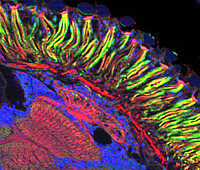Transport and stability of the Drosophila photoreceptor proteins rhodopsin and TRPL

Photoreceptor cells of the Drosophila compound eye provide a model system for studying transport of membrane proteins and major components of the transport pathways for the visual pigment rhodopsin have already been identified. These include several chaperones that escort rhodopsin through the secretory pathway as well as Rab GTPases and Rab-interacting proteins. Removal of rhodopsin from membranes usually depends on its interaction with arrestins but, in addition, an arrestin-independent internalization pathway depending on activation of the visual G-protein seems to exist. At least two of the proteins involved in rhodopsin transport, XPORT and Rab11, are also needed for transport of the ion channel TRP to the rhabdomeral photoreceptor membrane, suggesting a common transport pathway for TRP and rhodopsin. Transport of a second light-activated ion channel, TRPL, does not depend on XPORT and Rab11 and thus seems to utilize a distinct transport route.
In the proposed, project we intend to study the mechanisms underlying turnover of rhodopsin and TRPL and to identify new proteins of the rhodopsin and TRPL transport routes. By using a Drosophila mutant expressing a constitutively active Gqα protein, we will study the proposed G-protein-dependent, arrestin-independent rhodopsin internalization pathway. This mutant shows retinal degeneration and we will determine whether degeneration results from constitutive Ca2+ influx into photoreceptor cells or from enhanced rhodopsin internalization. To dissect these possibilities, we will either cross the constitutively active Gqα allele into mutant backgrounds that shut down phototransduction and hence Ca2+ influx downstream of Gqα or use flies that have a reduced rhodopsin content. With respect to TRPL transport, we have previously identified an orphan protein, termed CG30118, that is required for TRPL transport to the rhabdomere but not for transport of TRP or rhodopsin. We will characterize CG30118 biochemically and identify CG30118 interaction partners in order to get a clue on the context in which this protein functions in the transport of TRPL. Finally, we intend to identify new rhodopsin and TRPL interaction partners at certain light conditions that correspond to distinct steps of their turnover. Identification of these interaction partners will be achieved by a proteomics approach using co-immunoprecipitation and quantitative mass spectrometry. The feasibility of this method has been tested in preliminary experiments with TRPL that already resulted in identification of possible TRPL interaction partners, e.g. arrestin1, Synaptotagmin and 14-3-3 proteins. A role of these proteins in TRPL transport will now be studied. Collectively, the results of the project should contribute to the understanding of principle transport pathways for different types of integral plasma membrane proteins in photoreceptor cells.
Sponsored by DFG, HU 839/7-1
